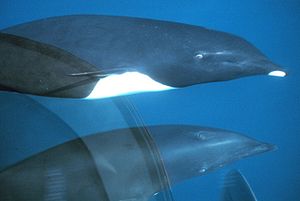Smooth dolphins
| Smooth dolphins | ||||||||||||
|---|---|---|---|---|---|---|---|---|---|---|---|---|

Northern smooth dolphin ( Lissodelphis borealis ) |
||||||||||||
| Systematics | ||||||||||||
|
||||||||||||
| Scientific name | ||||||||||||
| Lissodelphis | ||||||||||||
| Gloger , 1841 |
The smooth dolphins ( Lissodelphis ) are a genus of dolphins . Only two species belong to the genus, the northern smooth dolphin ( Lissodelphis borealis ) and the southern smooth dolphin ( Lissodelphis peronii ). They are characterized by the complete lack of a dorsal fin and are therefore very easy to spot.
features
Both species are slim and have small, pointed pectoral fins ( flippers ) and a relatively small tail fluke . As mentioned at the beginning, they have no back fins , so that they can be easily distinguished from all other dolphins on the open sea. Both species are also very similar in color. They have a white belly and are otherwise black, with the white surface spreading further in the southern species and also taking up the flippers as well as parts of the sides and the head.
The males of the northern smooth dolphins are about 2.2 meters long when fully grown, the females about 2.0 meters. The southern right dolphins are slightly larger at a maximum of 2.50 meters and, at around 100 kilograms, are also somewhat heavier compared to the 90 kilograms of their relatives. At birth, the animals are about half as long as adults, they live about 40 years.
distribution
The Northern Right Dolphin is native to the moderately warm Pacific Ocean , with its distribution ranging from Kamchatka and Japan on the Asian coast to British Columbia and Baja California on the American west coast. Nothing is known about migrations of the animals, but it is believed that they follow schools of their main food source, the octopus and squid . On the California coast , the animals have so far only been observed in summer, while in winter and spring they are in the high seas . Population figures are not known, about 14,000 individuals are believed to be on the American coast.
The southern right dolphin can be found around the south pole (circumpolar) between the 40th and 55th latitude south latitude in the moderately warm waters. They have occasionally been observed in the Tasman Sea off Australia .
behavior
Although both species of smooth dolphins have been known for a long time, their behavior is still largely unexplored. Both species are very sociable and form schools of several hundred animals. These can in turn join together in large groups of up to 3,000 individuals. There is also a mix with other social whales such as various other dolphins or pilot whales . With a top speed of 40 km / h, the smooth dolphins are also among the fastest swimmers among whales, where they can jump up to seven meters in height.
Normally, the smooth dolphins avoid boats, although "riding" animals have already been observed on the bow waves. Furthermore, no strandings of the northern smooth dolphin are known, of the southern smooth dolphin a stranding of 77 animals on Catham Island has been documented.
threat
The stock situation of the smooth define is classified as largely harmless. Both species are not hunted, but several thousand animals were killed by the nets of the trawling , which has been banned by the United Nations since 1993 .
attitude
There have been attempts to keep the northern right dolphin in aquariums , but most of the time the animals died within a maximum of three weeks for unknown reasons. A single individual lived in captivity for 15 months. There have been no attempts to keep the southern smooth dolphin.

